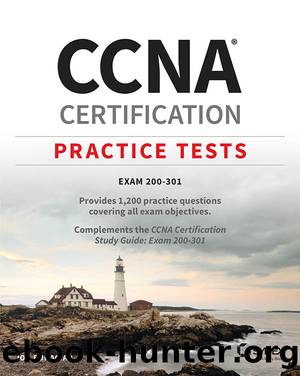CCNA Certification Practice Tests by Jon Buhagiar

Author:Jon Buhagiar [Buhagiar, Jon]
Language: eng
Format: epub
ISBN: 9781119669890
Publisher: Wiley
Published: 2020-03-13T13:00:00+00:00
C. The root bridge is elected by all of the switches and has the lowest MAC address and priority of all the switches in the network. The root bridge is not elected based upon a high or low IP address. Spanning Tree can function without an IP address, since it is a layer 2 loop avoidance.
A. The root bridge is a point of perspective for the rest of the STP network. It is important to have a point of perspective to calculate which ports are blocked and which remain in a forwarding mode. The root bridge has no influence on the forwarding decisions of frames. Each switch is responsible for its own calculation of STP; only the root bridge election is the consensus of all switches in the network.
C. The bridge ID is made up of a 2-byte bridge priority and a 6-byte MAC address for a total of 8 bytes. All of the other options are incorrect.
A. A designated port is a port that has the lowest cost compared to the higher cost of the redundant ports. It is placed into a forwarding state for a network segment. A designated port is determined to have the lowest cost, and not the highest cost, when it is placed into a forwarding state. A port that has the lowest cost to the root bridge is a root port and not a designated port. A port that has the highest cost to the root bridge is placed into a blocking state.
A. Every switch in the network segment must have at least one root port. This is the port that leads back to the root bridge. The root bridge will have a designated port on the adjacent link. Every switch will have an active link back to the root bridge; however, those ports leading back the root bridge are called root ports. A network may not have any alternate ports, depending on the topology and layout of the network. A network may not have any backup ports for the same reasons.
C. The root port is the port that leads back to the root bridge on the adjacent switch. It has the lowest cost of the redundant ports. A root port is determined to have the lowest cost to the root bridge, not a network segment. Root ports are always determined to have the lowest cost, not the highest cost.
A. The designated port is the port with the lowest cost of the redundant links to the network segment. The adjacent port is normally the root port leading back to the root bridge. A port that is determined to have the lowest cost or path cost to the root bridge is called the root port and not a designated port. The designated port will always have the lowest cost to a network segment, not the highest cost.
C. The PVST+ bridge ID comprises a 4-bit bridge priority calculated in blocks of 4096, a 12-bit sys-ext-id that is the VLAN ID for the segment, and a 6-byte MAC address for the switch. All of the other options are incorrect.
Download
This site does not store any files on its server. We only index and link to content provided by other sites. Please contact the content providers to delete copyright contents if any and email us, we'll remove relevant links or contents immediately.
Sass and Compass in Action by Wynn Netherland Nathan Weizenbaum Chris Eppstein Brandon Mathis(7399)
Grails in Action by Glen Smith Peter Ledbrook(7291)
Kotlin in Action by Dmitry Jemerov(4634)
Management Strategies for the Cloud Revolution: How Cloud Computing Is Transforming Business and Why You Can't Afford to Be Left Behind by Charles Babcock(4127)
The Age of Surveillance Capitalism by Shoshana Zuboff(3413)
Learn Windows PowerShell in a Month of Lunches by Don Jones(3236)
Mastering Azure Security by Mustafa Toroman and Tom Janetscheck(3015)
Mastering Python for Networking and Security by José Manuel Ortega(2937)
Blockchain Basics by Daniel Drescher(2884)
TCP IP by Todd Lammle(2633)
Microsoft 365 Identity and Services Exam Guide MS-100 by Aaron Guilmette(2541)
From CIA to APT: An Introduction to Cyber Security by Edward G. Amoroso & Matthew E. Amoroso(2478)
Hands-On Azure for Developers by Kamil Mrzyglod(2398)
React Native - Building Mobile Apps with JavaScript by Novick Vladimir(2336)
MCSA Windows Server 2016 Study Guide: Exam 70-740 by William Panek(2309)
The Social Psychology of Inequality by Unknown(2305)
The Art Of Deception by Kevin Mitnick(2295)
Configuring Windows Server Hybrid Advanced Services Exam Ref AZ-801 by Chris Gill(2293)
Azure Containers Explained by Wesley Haakman & Richard Hooper(2183)
